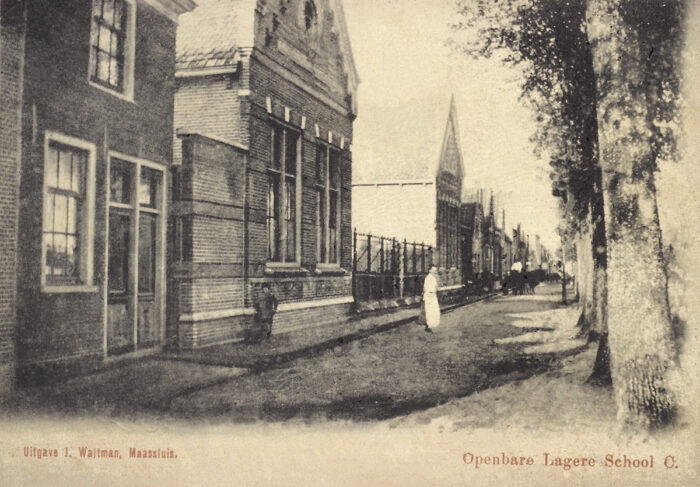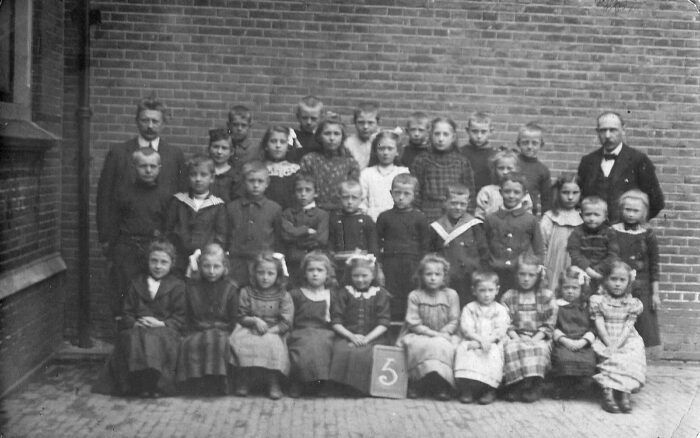
De school rond 1910
The school around 1910

Schoolklas in 1911
School class in 1911

Na de brand in 2003
After the fire, 2003
Op 5 april 1882 staat er in de Courant voor Maassluis, het Westland en Rozenburg dat de gemeente aan de Zuiddijk voor 6500 gulden een aantal huizen koopt om er een school te bouwen. Tijdens de bouw is men heel bezorgd omdat er verzakkingen optreden, maar die blijken gestopt te kunnen worden. Op maandag 21 juli 1884 wordt de nieuwgebouwde openbare school voor lager onderwijs aan on- en minvermogenden in gebruik genomen. Zonder officiële opening, staat in de Westlandsche Courant. In 1900 stapt Corrie van der Sluijs als zesjarig meisje de school binnen. Later zou ze aan al haar kinderen en kleinkinderen vertellen dat ze wel op de ‘drie centenschool’ zat, maar dat de kinderen daar géén klompen droegen.
Met de opening van deze school C had de stad drie openbare scholen. In de volksmond sprak iedereen van de ‘Dijkschool’. De school had een U-vorm met zes lokalen. In 1927 kwam het gebouw van school A vrij in de Reinestraat. Toen werd de Dijkschool daarheen overgeplaatst. In 1934 werd de school opgeheven.
Wat gebeurde er in het schoolgebouw aan de Zuiddijk na 1927? Daar vinden we berichten over terug in weekblad De Schakel en zijn voorgangers. In de jaren ’30 werden er jaarlijks tentoonstellingen gehouden van de ‘Ambachts-teekenschool’. Op deze school leerden jongens bouwkundige tekeningen, vlakvullingen, plattegronden, en dergelijke maken. Burgemeester en wethouders kwamen op de tentoonstellingen prijzen uitreiken aan de jongemannen die de beste tekeningen hadden gemaakt.
In 1938 voelde de overheid in Nederland de dreiging die er van Hitler Duitsland begon uit te gaan. Er werden regels opgesteld voor noodsituaties. Als het luchtalarm zou afgaan moest medisch personeel zich verzamelen in het schoolgebouw dat als geneeskundige hulppost zou worden ingericht. In de oorlogsjaren is het schoolgebouw niet gevorderd geweest door de bezetter, maar over wat er in het gebouw gebeurde lezen we niets.
Na de watersnoodramp in februari 1953 werd een inzamelingsactie in Maassluis gehouden voor wie huis en haard kwijt was in zuidwest Nederland. Kleding, beddengoed en huishoudtextiel werd verzameld, gesorteerd en verdeeld. Dit gebeurde allemaal in het schoolgebouw.
In mei 1953 kwam er tijdelijk de suikerwerkindustrie van de firma J. Engelbrecht in het gebouw. Eind 1954 ging die naar zijn definitieve vestiging in Schiedam.
In de jaren ’70 en ’80 is het gebouw gebruikt voor een kringloopwinkel annex 2e hands boekwinkel.
In 2003 werd het voormalige schoolgebouw aan de Zuiddijk ernstig beschadigd door brand, vooral aan de achterzijde. Besloten werd om de karakteristieke voorgevel te behouden en het gebouw te restaureren. In 2007 werd het opgeleverd met een aantal woonappartementen erin.
++++++++++++++++++++
LIVING IN THE DIJKSCHOOL
On April 5, 1882, the Newspaper for Maassluis, the Westland and Rozenburg states that the municipality buys a number of houses for 6500 guilders on the Zuiddijk to build a school there. During construction, people are very concerned because subsidence occurs, but it turns out that they can be stopped. On Monday, July 21, 1884, the newly built public school for primary education for the poor and less wealthy is inaugurated. Without official opening, it is stated in the Westlandsche Courant. In 1900, Corrie van der Sluijs entered the school as a six-year-old girl. Later she would tell all her children and grandchildren that she attended the ’three cents school’, but that the children did definitely not wear clogs there.
With the opening of this school C, the city had three public schools. Everyone spoke of the ‘Dijkschool’ in popular speech. The school had a U-shape with six classrooms. In 1927 the building of school A in the Reinestraat became available. Then the Dijkschool was transferred there. The school was closed in 1934.
What happened in the school building on the Zuiddijk after 1927? We find reports about this in the weekly magazine De Schakel and its predecessors. In the 1930s, annual exhibitions of the ‘Craft drawing school’ were held. At this school, boys learned to make architectural drawings, tessellations, floor plans, and the like. The Mayor and aldermen came to the exhibitions to award prizes to the young men who had made the best drawings.
In 1938, the government in the Netherlands sensed the threat that Hitler’s Germany was beginning to emanate. Rules were drawn up for emergencies. If the air raid sirens were to go off, medical personnel would have to gather in the school building that was to be set up as a medical aid station. During the war years, the school building was not requisitioned by the occupying forces, but we read nothing about what happened in the building.
After the flood disaster in February 1953, a fundraising campaign was held in Maassluis for those who had lost their home and hearth in the southwest of the Netherlands. Clothing, bedding and household textiles were collected, sorted and distributed. This all happened in the school building.
In May 1953 the confectionery industry of the firm J. Engelbrecht temporarily moved into the building. At the end of 1954 it went to its definitive location in Schiedam.
In the 1970s and 1980s, the building was used for a thrift shop annex second-hand bookshop.
In 2003 the former school building on the Zuiddijk was seriously damaged by fire, especially at the rear. It was decided to retain the characteristic facade and to build a new backside. In 2007 it was completed with a number of residential apartments in it.

De school rond 1910
The school around 1910

Schoolklas in 1911
School class in 1911

Na de brand in 2003
After the fire, 2003